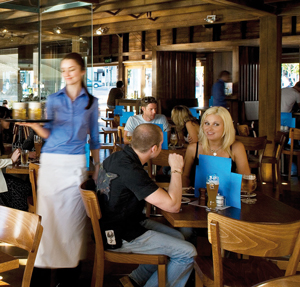AP automation adds up for Bavarian Hospitality

Devoted customers of the Bavarian Bier Café know there’s no better place to enjoy pure imported German beers with hearty fare like pork belly, chicken schnitzel and apple strudel. Keeping the larder stocked and the taps flowing is the responsibility of the Bavarian Hospitality Group (BHG), which has solved the problems of rapid business growth with a new invoice automation solution from Australia’s Efficiency Leaders.
Started by German-born restaurateur John Szangolies over 35 years ago, BHG now owns and runs a growing network of 16 restaurants across NSW and Queensland. BHG’s first restaurant, the Löwenbräu Keller in the Rocks, is a Sydney institution. In recent years the BHG brand has grown to include The Argyle, Sake Restaurant & Bar, The Cut Bar & Grill, and the Bavarian Bier Café.
In the past 12 months BHG has experienced rapid growth, adding five new venues, including the first interstate locations in Queensland. Even before the rapid expansion, manual processing of supplier invoices was growing increasingly unwieldy.
Lisa Margison, Financial Controller for the Bavarian Hospitality Group, said the BHG head office dealt with between 3500 - 4000 invoices a month. Without any EDI links with key suppliers, over 90% of these invoices arrive on paper and must be manually entered.
“There was lack of control over the processing of invoices,” said Margison. “Additionally all of the purchase orders (POs) were created manually and it meant we had a lack of visibility.”
The manual workflow that had evolved over time has also introduced multiple layers of duplication which added the potential for human error to introduce inaccuracies. Previously, invoices were handled a minimum of three times after being sent into head office.
“Each invoice was sent to the executive chef, who had them compiled into an Excel spreadsheet. Then all food and liquor invoices were entered manually into BHG’s inventory system, which was Micros at that point in time, after which they would come to the finance department and be entered into the accounting software,” explained Margison. “Being handled so many times and manually entered into two different systems saw many opportunities for human error.”
IT Manager Mohammed Dean had been assessing alternatives for invoice automation since 2009, but the rapid rollout of new stores in 2010 put on increased pressure to implement a solution.
“I had to make sure that the application mapped our needs,” said Dean. “I had a look at a number of proposals but they wouldn’t map to the Micros POS system or couldn’t talk to our Greentree financials. The Efficiency Leaders Automation Platform (ELAP) has delivered the integration that we required.”
“There is better integration between business units, inventory people are talking to financials, who are in turn talking to the venues. There is better interaction between every business unit. Data is accurate so people are more confident in talking to one another.”
In addition to adopting ELAP, BHG migrated from the Micros point of sale (POS) platform to an alternative from H&L. Efficiency Leaders provided the turnkey automation solution in 12 weeks.
The entire solution went live at the end of March and is now interfaced with a new SharePoint Foundation installation, to provide automatic archiving of invoice images and extracted data.
Invoices are scanned at the venues on MFPs and the scanned images are sent to the head office. ELAP then automatically interprets and validates the invoice. ELAP incorporates Kofax as a base processing platform. Kofax Capture VRS is used for image clean-up at the head office, while Kofax Transformation Modules and Validation are used for applying the ELAP business rules on the ingested data received from the locations. Efficiency Leaders also developed the custom connectors for Greentree Financials and H&L Sysnet to support full line item processing.
Validations are done in cooperation with the ABR Web service, Sysnet and Greentree. Exceptions are handled by operators at the head office. When the invoice is valid, the relevant details are automatically exported to Greentree, Sysnet, and SharePoint Foundation.
Suppliers must now include a PO number on the invoice along with specific article codes and quantities. It’s no longer sufficient to invoice for a box of apples, the numbers or weight must be specified.
“We haven’t had any resistance from suppliers,” said Margison. “They are all happy to contribute to a more efficient payment system.”
Business rules are applied once an invoice has been scanned into H & L. If the data matches the PO it can go straight through for payment from Greentree financials. If there are exceptions, if quantities are outside a certain limit, it will be queried by a validation operator.
“The exceptions generally come from variances in quantity or weight of foodstuffs, for instance you ordered 2kg of fish and you get 2.1kg. It depends on the business rules you set whether that gets processed or comes up as an exception,” said Dean.
Since the new ELAP system was installed in March, Lisa Margison has been delighted with the transparency and the efficiencies of the invoice automation platform.
“The business is now well placed to manage the rapid expansion plans without increasing back office overheads. This would not have been possible without this technology.
“We now have transparency with purchase orders being raised first in H&L. We now have the control and visibility of our food and liquor costs.”
Staff at the group’s 16 restaurants are able to search for past invoices in SharePoint via the BHG intranet, avoiding another bottleneck in sending inquiries via the head office.
“We have added five new venues without any new staff, I don’t think we would have been able to do that without introducing this solution,” said Margison.
“During this whole transformation, Efficiency Leaders has consistently underpromised and overdelivered. Our requirements were constantly changing and they easily accommodated any changes. They were very easy to deal with.”
